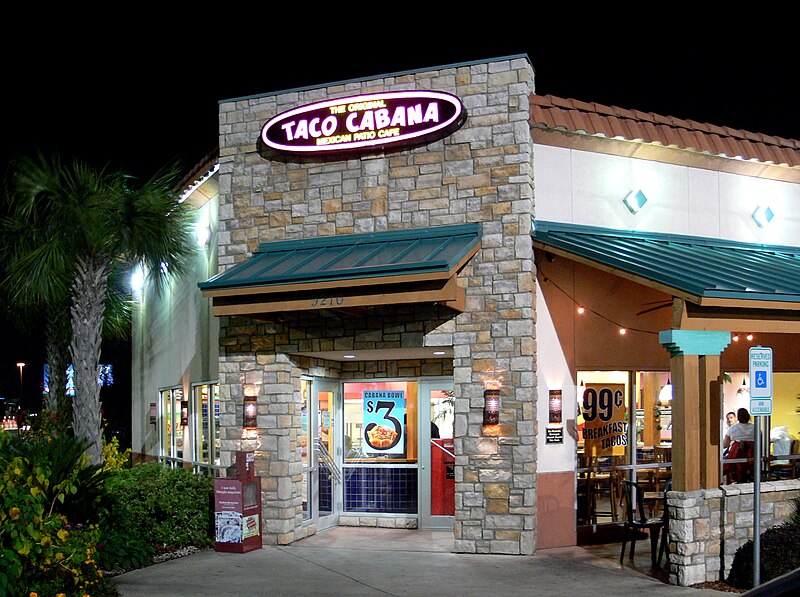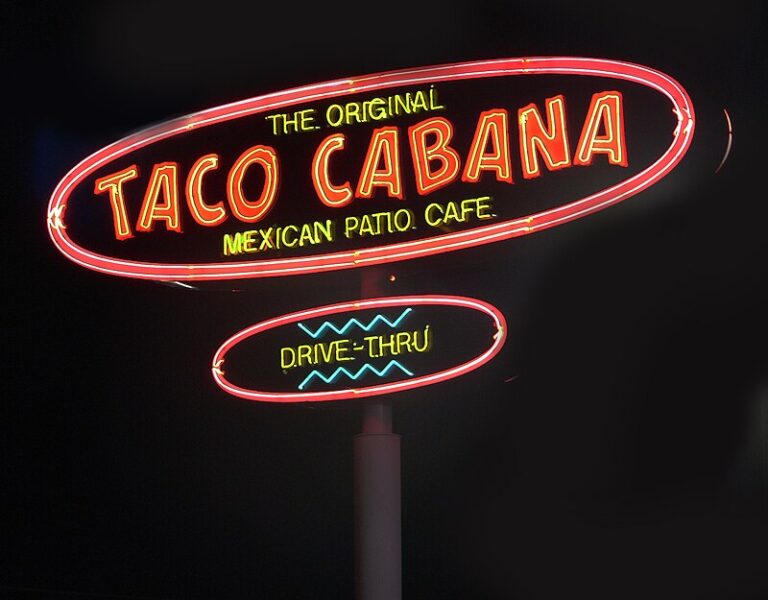Taco Cabana began when the Stehling brothers converted a vacant Dairy Queen in San Antonio into a bright pink Tex-Mex restaurant in 1978. After thieves stole their patio furniture on opening night, they decided to stay open 24 hours instead of investing in security. Felix and Billie Jo Stehling’s commitment to fresh ingredients, accessible prices, and beer-and-margarita service helped the pink patio concept rapidly expand throughout Texas. Their serendipitous service model would help reshape fast-casual Tex-Mex dining.
Image: Photo: Andreas Praefcke, Taco Cabana Dallas sign, CC BY 3.0
A Dairy Queen Transforms: The Birth of a Tex-Mex Icon
How does a vacant Dairy Queen become one of Texas’s most recognizable restaurant chains? In San Antonio, Felix Stehling saw potential in an abandoned building that had sat empty for years. Initially leasing the property for parking for his bar, the Crystal Pistol, Stehling decided the space deserved more.
The Dairy Queen shell gave way to a complete remodeling. Stehling, along with his brother Mike, converted the forgotten structure into a taco stand serving Mexican food at the corner of San Pedro and Hildebrand. The signature bright pink paint—now iconic—was chosen during this renovation to catch eyes and build brand recognition. One early challenge occurred when thieves stole all of the patio furniture shortly after opening.
With fresh ingredients, value-minded pricing, and alcoholic beverages like beer and margaritas, Taco Cabana quickly distinguished itself from competitors in the Texas food landscape. Today, the restaurant chain has expanded throughout Texas, including locations in suburban communities like the Cypress area that have transformed from rural farmland to major residential developments.
Felix & Billie Jo Stehling: The Visionaries Behind the Pink
Behind every iconic brand stand visionaries who transform simple ideas into cultural landmarks. Felix and Billie Jo Stehling, married since 1960, built this Tex-Mex phenomenon through complementary talents.
Felix, co-founding Taco Cabana in 1978, brought culinary verve (he’s widely credited in San Antonio with popularizing the bean burger) while recruiting seasoned cooks to guarantee quality.
Billie Jo’s thematic design vision gave Taco Cabana its unmistakable identity. She shaped the memorable pink patio concept that became the chain’s visual signature, establishing an inviting outdoor dining atmosphere that defined the brand.
Together, they implemented a family-run model emphasizing fresh, homemade recipes and 24-hour service. This collaboration turned a repurposed Dairy Queen into a Tex-Mex favorite that influenced casual dining across Texas.
The Accidental 24-Hour Restaurant: How Theft Shaped Business Strategy

The Stehlings’ business acumen faced an unexpected test just as their Tex-Mex dream was taking shape. After the first night of business, they discovered their chained patio furniture had been stolen—an incident that would unexpectedly define their brand identity.
Rather than increasing security measures and absorbing higher operational costs, Felix made a bold decision: keep the restaurant open 24 hours a day. This practical solution eliminated the need for securing furniture overnight while creating a distinctive service model that attracted late-night diners.
What began as a response to theft became a cornerstone of Taco Cabana’s appeal. The pink patio, now constantly occupied, shaped positive customer perceptions and cultivated loyalty.
From Bar Overflow to Cultural Phenomenon: The Early Growth Years
While Felix Stehling originally leased the vacant Dairy Queen to provide parking for the Crystal Pistol, this pragmatic decision unexpectedly laid the foundation for a Tex-Mex chain. By recruiting family members and experienced local cooks, Stehling rapidly expanded to multiple San Antonio locations, cultivating strong community loyalty.
The restaurant’s success wasn’t accidental. Menu innovations centered on fresh, made-from-scratch Tex-Mex dishes rather than processed alternatives, while maintaining affordable prices. The continuous 24-hour service attracted both late-night bar patrons and daytime diners, creating a broad customer base. Serving beer and margaritas alongside tacos, fajitas, and breakfast plates set Taco Cabana apart from typical fast-food competitors.
Billie Jo Stehling’s distinctive décor and the signature open-air patio established a casual, communal atmosphere that resonated with Texas and Mexican-American communities, transforming what began as bar overflow into a beloved cultural institution.
Fresh Over Fast: The Culinary Philosophy That Set Taco Cabana Apart
View this post on Instagram
At the heart of Taco Cabana’s rise stood a straightforward culinary philosophy: fresh would always trump fast. Unlike competitors relying on frozen shortcuts, Taco Cabana received regular deliveries of fresh meat and produce, with staples prepared daily from scratch.
This commitment to quality became their defining advantage. Recipes reflected home-style Tex-Mex flavors shaped by the cooks themselves. The approach deliberately balanced value with freshness—keeping prices accessible while never compromising on ingredients. This distinctive strategy helped Taco Cabana post strong same-store performance through the 1990s and into the early 2000s, before the brand later became part of what would become Fiesta Restaurant Group following its 2001 sale to Carrols.
The Pink Patio Revolution: Reimagining Fast-Casual Dining Spaces
Walking into a Taco Cabana today, you’re immediately struck by what became the chain’s most distinctive feature—vibrant pink patios that reimagined fast-casual dining spaces. These signature patios aren’t just about aesthetics; they’ve reshaped the guest experience while supporting efficient operations.
The pink patio concept advanced Taco Cabana through:
-
Semi-enclosed designs that blend outdoor appeal with weather protection
-
Open views to the grill line, showcasing fresh cooking and hand-pressed tortillas
-
Flexible seating that extends capacity and fosters a fiesta-like atmosphere
These design choices transport you to a Tex-Mex oasis where papel picado and festive lighting create an immersive environment distinct from standard fast-casual competitors. The Babcock Road location in San Antonio served as an early prototype for the patio style that would define the chain’s aesthetic.
Margaritas and More: How Alcohol Sales Differentiated the Brand
How many fast-casual chains can boast a signature margarita alongside their tacos? Taco Cabana’s early adoption of alcoholic beverages set it apart in the Tex-Mex space, lifting average checks and drawing evening and late-night traffic.
You’ll find an evolution in offerings—from classic frozen and on-the-rocks margaritas to rotating limited-time flavors and beer selections. In recent years, the brand also leveraged to-go programs where permitted, with value promotions like Margarita Mondays and daily happy hours continuing to draw crowds—proof that alcohol remains central to the brand’s Texan identity.
Family Feuds and Corporate Evolution: Navigating Growth Challenges
Three Stehling brothers helped launch Taco Cabana’s foundation, but their partnership didn’t survive the pressures of rapid expansion. By the mid-1980s, disagreements over management and growth led Felix’s brothers to exit, changing the company’s trajectory.
The shift from family business to corporate entity brought significant changes:
-
External leadership, including Richard Cervera in 1990, professionalized operations and growth strategy
-
The 1992 IPO provided capital for expansion while introducing new market pressures
-
Scaling raised challenges in maintaining consistency across a growing footprint
These transitions culminated in the 2001 acquisition by Carrols, and later the formation of Fiesta Restaurant Group, which would oversee Taco Cabana alongside Pollo Tropical before the brand’s subsequent sale in the 2020s.
Beyond San Antonio: The Texas Expansion Story
View this post on Instagram
As family dynamics reshuffled and corporate structures took shape, Taco Cabana looked beyond its San Antonio birthplace. Under strategic leadership in the early 1990s, the company implemented disciplined growth that boosted sales and widened its footprint across Texas and into select neighboring markets.
Expansion didn’t just cross city limits—it transformed operations. Newer stores adapted footprints for different climates and real-estate conditions, with more covered or enclosed patios outside South Texas. These modifications helped control costs while preserving brand identity. Even so, some out-of-state forays, such as Phoenix-area sites, later closed due to underperformance—underscoring the balance between ambition and the quality that made Taco Cabana a Texas favorite.
The Cultural Impact: How a Pink Patio Became a Texan Landmark
The humble pink patio at Taco Cabana represents far more than outdoor seating—it’s become a cultural touchstone woven into Texas identity. Since 1978, this vibrant signature has turned ordinary restaurants into community hubs where generations of Texans gather.
The patios foster a welcoming atmosphere that blends Texan sociability with Mexican-American heritage. Semi-enclosed spaces encourage real conversation; the color and décor echo festive traditions; and 24-hour service historically kept the lights on for after-game meals, late-night study breaks, and early-morning breakfasts. Even as prototypes evolve with modern conveniences like expanded drive-thru capacity, the pink patio remains the physical expression of Taco Cabana’s communal spirit.


